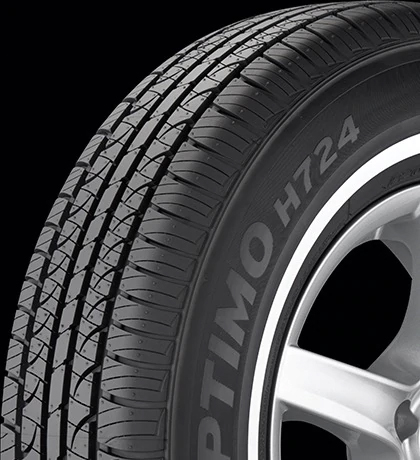Not much work getting done on Donna. We are waiting for the body guy to take her. Meanwhile we have made some decisions about the drive train which led to ordering a lot of parts to be ready to rebuild the C4 transmission and the 8 inch rear end.
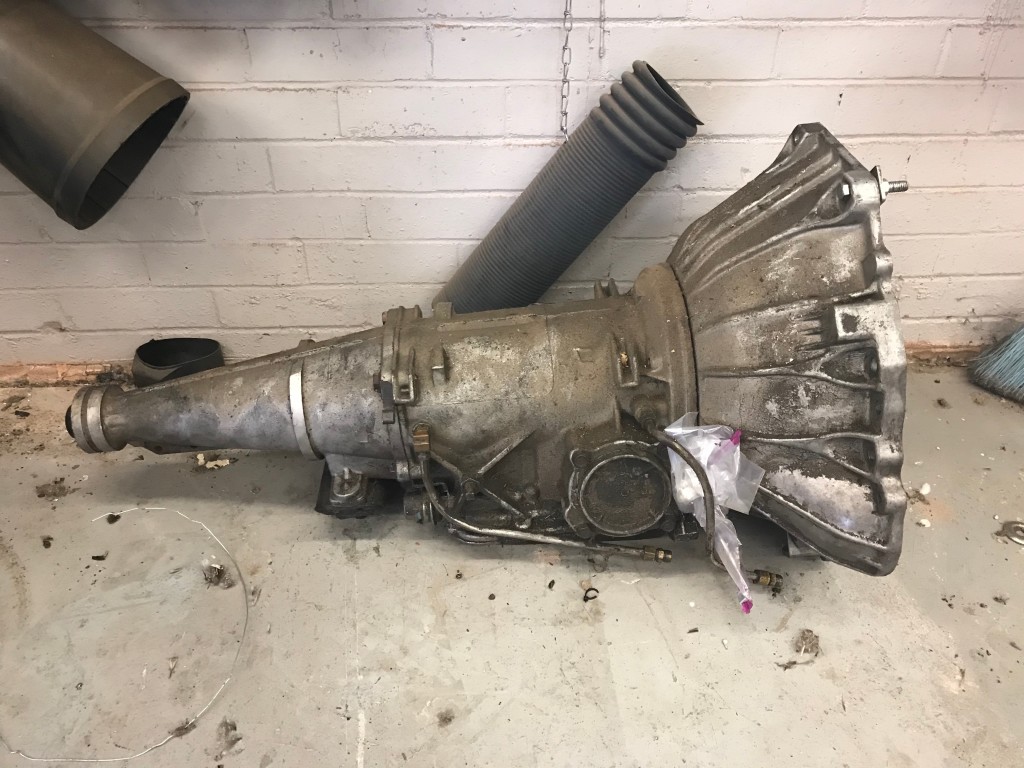
Donna was born with a Select Shift Cruise-O-Matic transmission, commonly referred to as a C4. She has 3 forward gears and reverse, hence the “4” in C4. The forward gear ratios are:
1st – 2.46
2nd – 1.46
3rd – 1.0
This means in 1st gear the engine turns 2.46 revolutions for every 1 revolution of the drive shaft, 2nd is 1.46 engine turns to 1 drive shaft turn, and 3rd is 1 turn of engine produces 1 turn of driveshaft.
We thought about putting an overdrive transmission into Donna to get the 0.67 overdrive gear, but after we looked into what that took and how much we would have to change, we decided to stick with the C4. This limits us in other areas, but more about that in a bit.
The transmission has valves that control when a shift occurs and to some degree how quickly that shift happens. There are clutch plates and friction plates that transmit the force of the engine to the driveshaft and two solenoids that engage the bands in the transmission to put it in a particular gear. All this can be rebuilt.
We ordered a complete rebuild kit from Oregon Performance. It includes high performance clutches, kevlar bands, and every rubber seal, paper gasket, O-ring, sealing ring, and metal clad seal that we will need to complete our rebuild. We added a TransGo Stage 2 Shift Kit which will raise overall line pressure, give 75% quicker 2-3 shifts, improve pressure for passing gear between 32-45 mph, eliminate too easy and too often passing gear, and provide quicker action throughout all shifting. We will also upgrade the servo to a “C-code” which is larger and will provide more force for firmer, better shifts.
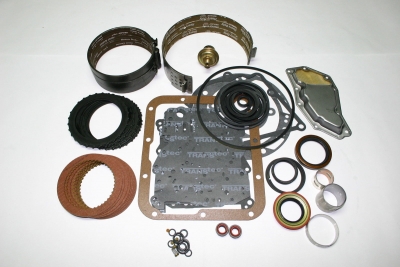
Finally, after talking to the shop that will rebuild the engine, we decided to install a torque convertor with a 2000rpm stall speed, vs the stock 1500 or so. This will let Donna get a little farther up in the power curve before applying power to the wheels, making her a little faster off the line.
How Donna performs both in quickness off the line and in cruising is a combination of the engine, transmission and the rear end.

Donna has the veritable Ford 8 inch differential. While not quite as stocky as the 9″, the 8 is a workhorse and has transferred horsepower to wheels for too many Ford vehicles to name or count. Reading the tag from Donna’s rear end we can ascertain several things.

This is the correct 8 inch rear end for a 69 Mustang Coupe. It was manufactured August 3rd, 1968, almost 3 months before Donna was born, and it is equipped with 2.79 gears.
The 2.79:1 gear ratio is determined by the number of teeth on the pinion gear and the the ring gear. The drive shaft rotates the pinion gear, which drives the ring gear, which drives the axels. In a 2.79 gear ratio there are 14 teeth on the pinion gear and 39 teeth on the ring gear. Since 14 goes into 39 exactly 2.79 times, this means that the drive shaft must spin 2.79 times for the wheels to spin once. For Donna to be faster off the line, we would need to increase this ratio so the driveshaft is spinning faster (and therefore the transmission and also the engine) to be more powerful. Speed is about power.
However, if we increase the gear ratio and Donna gets faster off the line, the engine will also be turning faster at highway speeds and our drivability and fuel economy go out the window. In fact, we can get a high enough gear for the rear, that Donna wouldn’t be able to drive highway speeds for any length of time due to the high rpms that would be necessary.
If we had chosen to install an AOD (overdrive tranny) we could have gone with a much higher rear gear and still been able to drive on the highway due to the 0.67 over drive gear in the tranny.
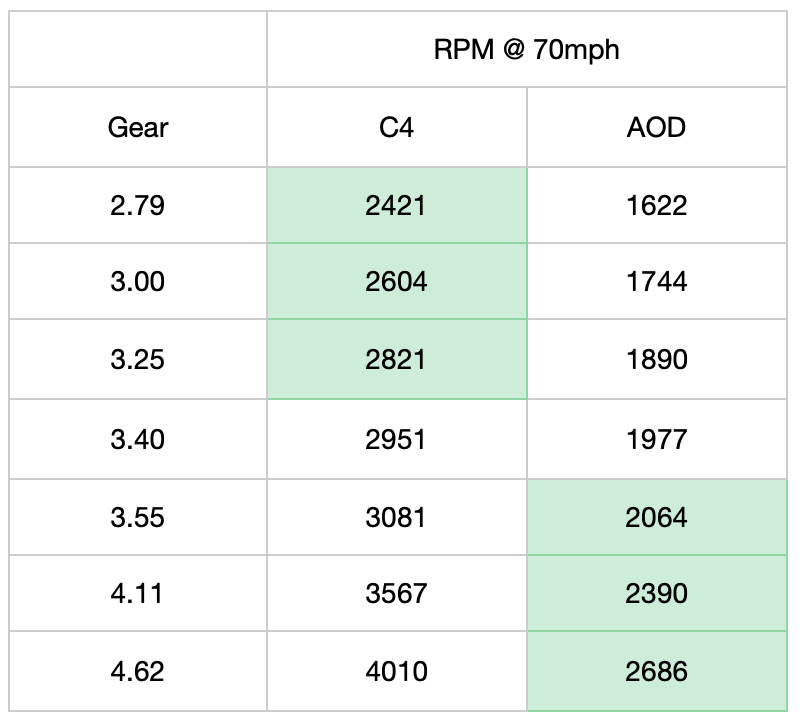
So Donna’s original gear has us cruising 70 and 2421 rpms. Not bad. A 3.00 gear brings us up to 2604, still driveable. However, at 3.25 and above the rpm’s at 70 make extended highway driving less desirable.
So we decide to go with the 3.00 gear to get a little more in-town pep, but not completely trash highway driving. This ratio still has 14 teeth on the pinion gear but has 42 teeth on the ring gear. 14 goes into 42 exactly 3.00 times, So now the drive shaft will rotate 3 times for the wheels to rotate once. We ordered Motive Ring and Pinion gears and an install set from Summit.

Remember the tag on the rear end? The fact that the gear ratio was written 2.79 tells us that Donna has an open differential, as opposed to a limited slip or positive traction differential. If you are running an open differential and you hit a loose patch, the differential will send power to the wheel that is encountering the least resistance. This results in wheel spin on the loose patch side, while the solid contact side barely moves. Limited slip differentials operate in a manner opposite an open system. When a limited slip diff senses that a wheel is spinning, it will automatically transmit more power to the wheel that has more traction.
Originally, limited slip diffs (LSD) had clutches in them similar to a transmission, which could wear and eventually the LSD would act like an open differential. Newer designs have helical gears that perform the same function, but do not wear out.
We bought Donna an Eaton Detroit Truetrac carrier. If she had been born with an LSD, the rear end tag would have been marked “2L79 – 8”, with the “L” standing for Limited Slip. Since we are changing both her gear ratio and the carrier, we ordered her a new tag from Marti, the only company licensed by Ford to do this, that will be marked “3L00 – 8” with the rest of the markings the same as her original.
Finally, we have the rims and wheels. We have the original rims Donna was born with. We will strip, powdercoat, and reuse them. They are 14×5 rims with a 5×4.5 PCD, or lug bolt pattern.
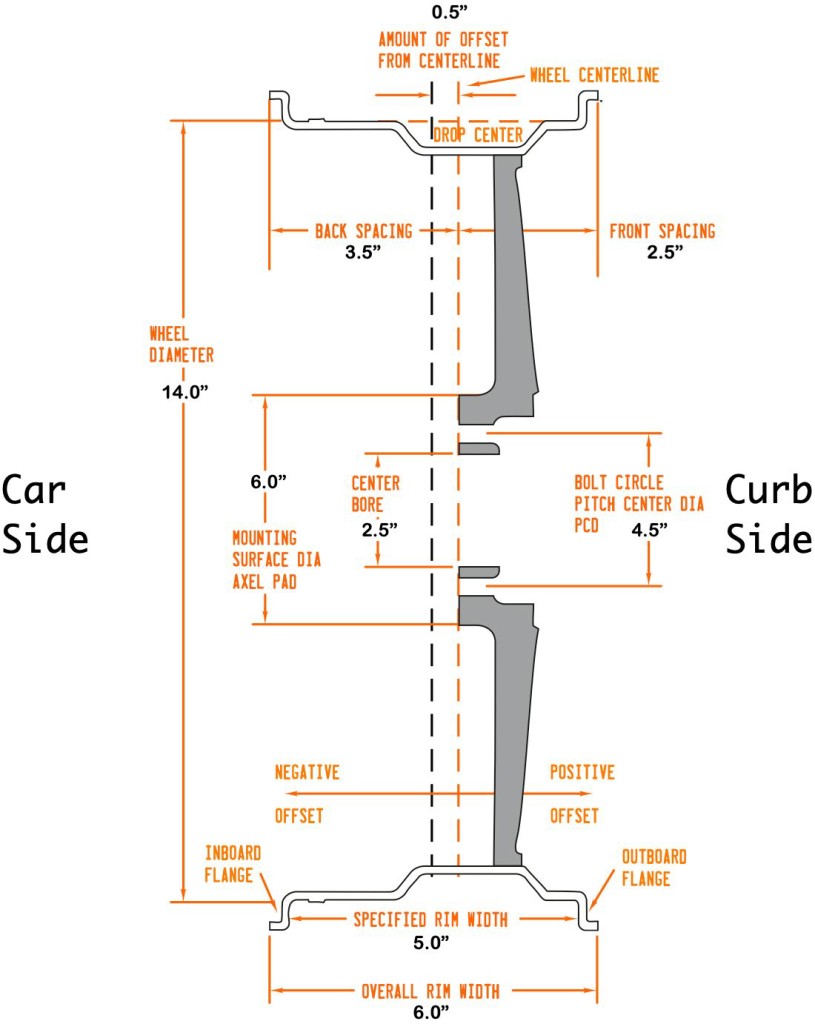
Donna came with 7.35×14 radial ply tires. In the 50 years since she was born they have changed the way tires are specified. Now tires are measure by width in mm, an aspect ratio to determine sidewall height, and the rim diameter.
The 7.35×14 tires had an aspect ratio of 85%, meaning the sidewall height was 85% of the width. The total diameter of the tire is very important as the speedometer is calibrated for this measurement. 85% of 7.35 is 6.03. Multiply that by 2 (there is tire on both the top and bottom of the wheel) to get 12.06 and then add 14 (the rim diameter) to get 26.06 as the diameter of Donna’s original wheels.
In modern tires there are only a few options that are close to Donna’s original tire diameter.
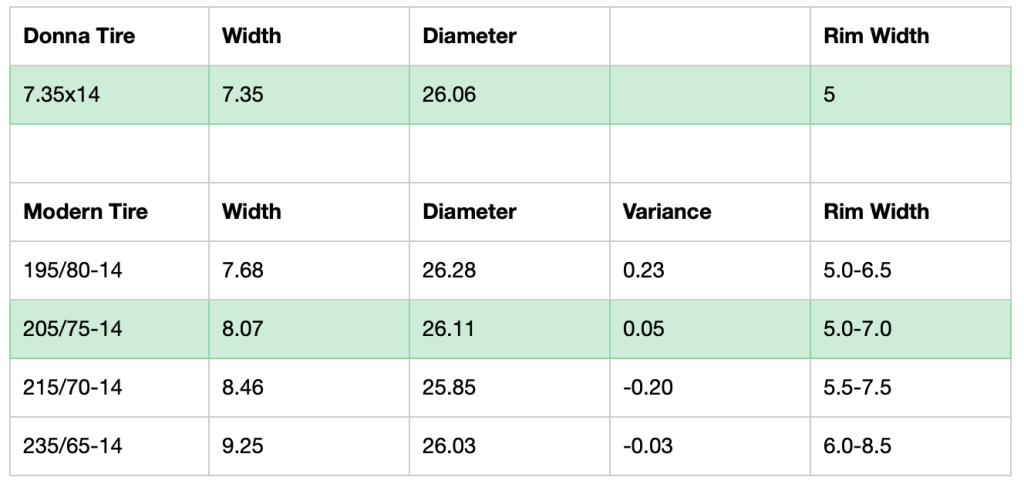
Of all the tires currently being made, those are the only 4 that fit on a 14 inch diameter rim and are within 0.5 inch of the original diameter. While the 235/65-14 is closest, the width of the tire could be a problem and it won’t be happy mounted on a 5″ rim. So the best option is a 205/75-14. We will probably go with a Hankook
Optimo H724. It is a good tire that is available in a thin white wall, which will be a nice touch.
